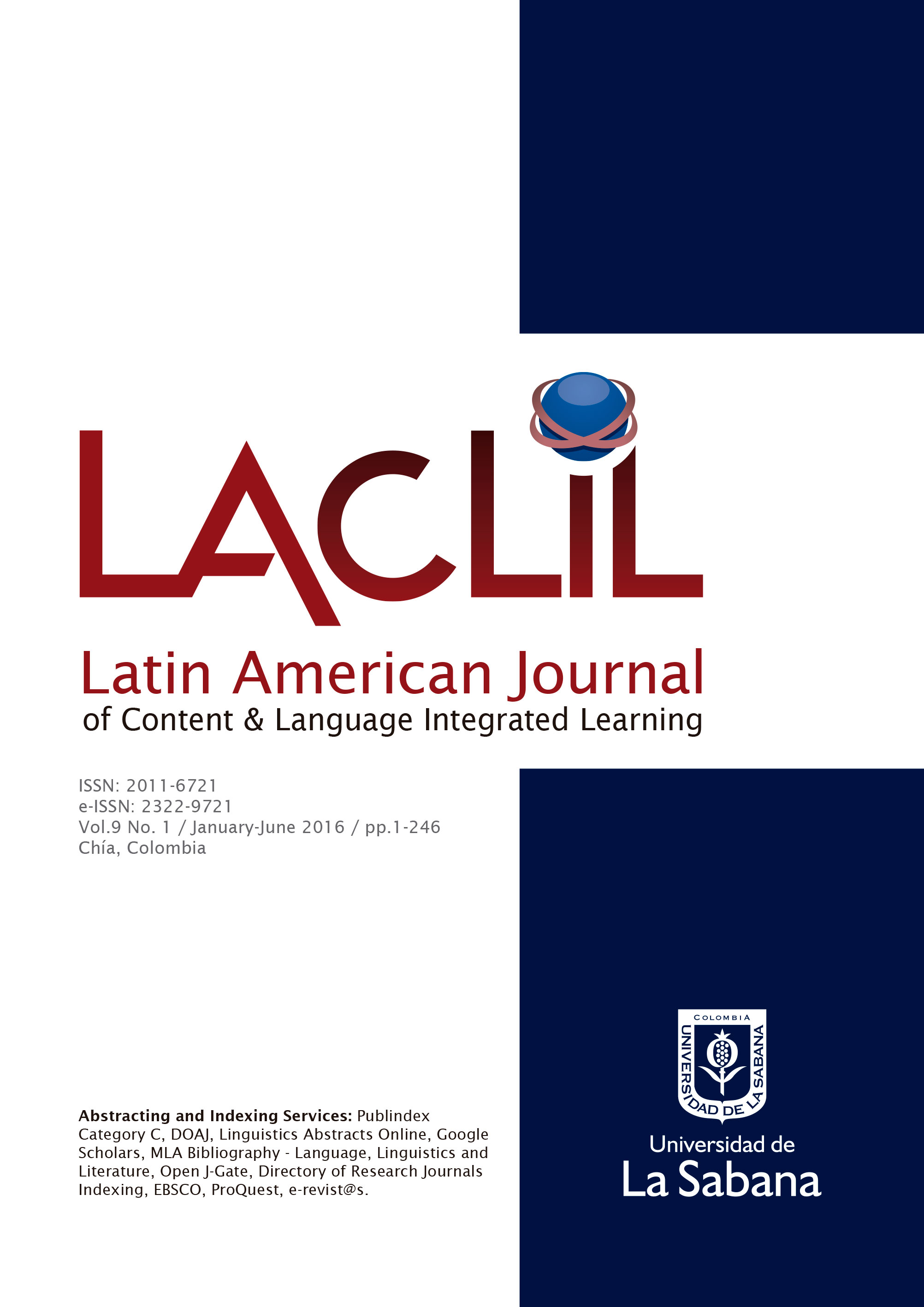Using online translators in the second language classroom: Ideas for advanced-level Spanish
DOI:
https://doi.org/10.5294/6007Keywords:
Online translators, editing online translator output, advanced-level Spanish learning, metalinguistic awareness, learning subordinate clauses in Spanish.Abstract
In this paper, we discuss the benefits of using online translators in the foreignlanguage classroom. Specifically, we discuss how faulty online translator outputcan be used to create activities that help raise metalinguistic awareness of secondlanguage grammar and of the differences between grammatical constructionsin the first and second language, which can help with the language learningprocess. Specific structures for advanced-level Spanish that produce faulty onlinetranslator output are explained, and then we provide sample editing-type activitiesfor these structures, as well as anecdotal evidence regarding students’ reactionsto these tasks. Although the activities discussed are specifically designedfor Spanish, they may also be used as a model for other languages. Importantly,these activities may prove helpful for Spanish teachers because these structuresare covered in many university-level advanced Spanish grammar courses. Thesetypes of activities could also ultimately help students who will be seeking translation-oriented jobs.
Downloads
References
Alderson, J. C., Clapham, C., & Steel, D. (1997). Metalinguistic knowledge, language aptitude and language proficiency. Language Teaching Research, 1(2), 93-121.
Alipour, S. (2014). Metalinguistic and linguistic knowledge in foreign language learners. Theory and Practice in Language Studies, 4(12), 2640-2645.
Berg, E. C. (1999). The effects of trained peer response on ESL students’ revision types and writing quality. Journal of Second Language Writing, 8(3), 215-241.
Bialystok, E. (1979). Explicit and implicit judgements of L2 grammaticality of L2 grammaticality. Language Learning, 29(1), 81-103.
Bialystok, E. (1981). The role of linguistic knowledge in second language use. Studies in Second Language Acquisition, 4(1), 31-45.
Burton, C. (2003). Idea: The online translator: Implementing national standard 4.1. Hispania, 86(2), 320-321.
Butt, J., & Carmen, B. (2004). A new reference grammar of modern Spanish. New York, NY: McGraw-Hill.
Byrd, D. R. (2003). Practical tips for implementing peer editing tasks in the foreign language classroom. Foreign Language Annals, 36(3), 434-441.
Campos, H. (1993). De la oración simple a la oración compuesta. Washington, DC: Georgetown University Press.
Correa, M. (2011). Subjunctive accuracy and metalinguistic knowledge of L2 learners of Spanish. Electronic Journal of Foreign Language Teaching, 8(1), 39-56.
Correa, M. (2014). Leaving the “peer” out of peer-editing: Online translators as a pedagogical tool in the Spanish as a second language classroom. Latin American Journal of Content and Language Integrated Learning, 7(1), 1-20.
French, J. R. (1991). Machine translation. In W. Brierley & I. R. Kemble (Eds.), Computers as a tool in language teaching (pp. 55-69). Chichester, West Sussex: Ellis Horwood Limited.
Garcia, I., & Pena, M. I. (2011). Machine translation-assisted language learning: writing for beginners. Computer Assisted Language Learning, 24(5), 471-487.
Hansen, J. G., & Liu, J. (2005). Guiding principles for effective peer response. ELT Journal, 59(1), 31-38.
Kliffer, M. D. (2005). An experiment in MT post-editing by a class of intermediate/advanced French majors. In Proceedings of EAMT, 10th Annual Conference (pp. 160-165).
Budapest, Hungary.
Koike, D. A., & Klee, C. A. Lingüística aplicada: Adquisición del español como segunda lengua. New York, NY: Wiley.
Larousse. (Eds.). (2010). Gramática lengua española: Reglas y ejercicios. México, DF: Larousse México.
Lundstrom, K., & Baker, W. (2009). To give is better than to receive: The benefits of peer review to the reviewer’s own writing. Journal of Second Language Writing, 18(1), 30-43.
Lunn, P. V., & DeCesaris, J. A. (2006). Investigación de gramática. Boston, MA: Heinle Cengage Learning.
Luton, L. (2003). If the computer did my homework, how come I didn’t get an “A”? The French Review, 76(4), 766-770.
National Standards in Foreign Language Education Project. (2015). World-readiness standards for learning languages. Alexandria, VA: Author.
Niño, A. (2008). Evaluating the use of machine translation post-editing in the foreign language class. Computer Assisted Language Learning, 21(1), 29-49.
Niño, A. (2009). Machine translation in foreign language learning: Language learners’ and tutors’ perceptions of its advantages and disadvantages. ReCALL, 21(2), 241-258.
O’Neill, E. M. (2012). The effect of online translators on L2 writing in French (Unpublished doctoral dissertation). University of Illinois at Urbana-Champaign, Urbana, IL.
Renou, J. (2001). An examination of the relationship between metalinguistic awareness and second-language proficiency of adult learners of French. Language Awareness, 10(4), 248-267.
Richmond, I. M. (1994). Doing it backwards: Using translation software to teach target-language grammaticality. Computer Assisted Language Learning, 7(1), 65-78.
Roehr, K. (2007). Metalinguistic knowledge and language ability in university-level L2 learners. Applied Linguistics, 29(2), 173-199.
Shei, C.-C. (2002). Teaching MT through pre-editing: Three case studies. In Proceedings of the 6th EAMT Workshop Teaching Machine Translation (pp. 89-98). Manchester, UK:
EAMT.
Somers, H. (2003). Machine translation in the classroom. In H. Somers (Ed.), Computers and translation. A translator’s guide (pp. 319-340). Amsterdam/Philadelphia: Benjamins.
Whitley, M. S., & González, L. (2007). Gramática para la composición. Washington, DC: Georgetown University Press.
Williams, L. (2006). Web-based machine translation as a tool for promoting electronic literacy and language awareness. Foreign Language Annals, 39(4), 565-578.
Downloads
Published
How to Cite
Issue
Section
License
This Journal and its articles are published under the Creative Commons CC BY 4.0 DEED Attribution 4.0 International license. You are free to: Share — copy and redistribute the material in any medium or format for any purpose, even commercially. Adapt — remix, transform, and build upon the material for any purpose, even commercially. The license cannot revoke these freedoms as long as you follow the terms of the license.








